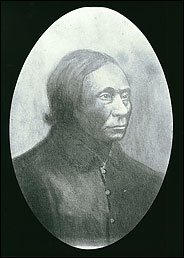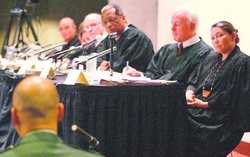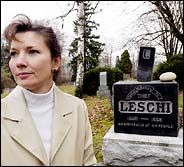Chief Leschi Exonerated of Murder - 146 Years After
His Execution
by Hans Sherrer
For Justice:Denied magazine
(Washington Historical Society)
 Thirty-four
years before the Washington Territory became the state of Washington,
the Nisqually Indian Nation and white settlers in the Puget Sound
area were engaged in what became known as the Indian War of 1855-56.
The territorial government precipitated the war after members of the
Nisqually Tribe refused to agree to a land cession treaty that would
have created a 900 acre reservation in western Washington for the
tribe.
Thirty-four
years before the Washington Territory became the state of Washington,
the Nisqually Indian Nation and white settlers in the Puget Sound
area were engaged in what became known as the Indian War of 1855-56.
The territorial government precipitated the war after members of the
Nisqually Tribe refused to agree to a land cession treaty that would
have created a 900 acre reservation in western Washington for the
tribe.
On October 31, 1855
a firefight occurred east of present day Tacoma between the
territorial militia and members of the Nisqually Tribe. During that
skirmish, volunteer militiaman Colonel Abrams Moses was shot and
killed
Territorial Governor
Isaac Stevens blamed Nisqually Chief Leschi for Moses’
“murder,” and ordered his arrest. More than a year later,
Leschi surrendered after being assured by the Army that he wouldn’t
be prosecuted for acts committed by the Nisqually during the war.
However Gov. Stevens didn’t think the territorial government
was bound by the Army’s agreement. On November 16, 1856, three
days after his arrest, Leschi was put on trial for Moses’
“murder” in the federal territorial court.
The prosecution’s
case rested on one eyewitness - Antonio Rabbeson - who claimed Leschi
was present when Moses was shot. However Leschi claimed he wasn’t
involved in the skirmish during which Moses was killed, and his
counsel vigorously attacked Rabbeson’s credibility. One
distinct irregularity was Rabbeson chaired the grand jury that
indicted Leschi for capital murder. The trial ended in a hung jury
because two jurors held out for Leschi’s acquittal. One of
those jurors, Ezra Meeker, stated that Rabbeson was “obviously
lying.” 1
Leschi was convicted
of murder and sentenced to death after a retrial in March 1857. The
territorial Supreme Court affirmed his conviction after refusing to
consider new evidence - a map by the Army that indicated Leschi was
miles away from the scene of Moses’ death. In its decision, the
Court wrote that Leschi was the “leader of the Indian forces
that “cruelly waged” war on settlers, “sacrificing
citizens” in the Puget Sound region.” 2
The Court’s decision exhibited passion and prejudice against
Leschi, who was the chief of the Nisqually Tribe that had been
hostile to being displaced from their lands by white settlers. Leschi
was hanged on February 19, 1858 outside of Fort Steilacoom, south of
present day Tacoma. The Army refused to participate on the grounds
that Moses was a casualty of war, and had not been murdered. At the
time many people, including his executioner, believed Leschi was
innocent. Charles Grainger, his hangman later said, “I felt
then I was hanging an innocent man, and I believe it yet.” 3
Since the time of
his conviction and execution, the Nisqually have considered that
Chief Leschi was unfairly prosecuted for Moses’ death.
Beginning in 2002, members of the Nisqually Tribe, including some of
Leschi’s descendants, began a concerted campaign to clear his
name. The effort paid off in 2004 when both the Washington State
House and Senate passed resolutions recommending that the State
Supreme Court conduct an extraordinary review of Leschi’s
conviction. Although Chief Justice Gerry Alexander declined to have
the Supreme Court review the conviction, he was instrumental in
organizing a Historical Court of Inquiry and Justice to retry Leschi
in absentia.
The trial was
arranged to be held on December 10, 2004, in a make-shift courtroom
seating about 200 people in the basement of the Washington State
Historical Society in Tacoma. Seven judges were selected to sit in
judgment of the case - six state judges, including Chief Justice
Alexander, and a judge representing the Nisqually Tribe. Alexander
said before the trial, “This really is uncharted territory.
It's got real challenges and greater difficulty.” 4
Indicative of the trial’s uncharted territory, is it was a
hybrid adversarial proceeding, combining elements of both a trial and
an appellate review.

The
seven judges at Chief Leschi’s retrial on December 10, 2004.
(Drew Perine/The News Tribune)
Chief Leschi’s
retrial attracted national attention. The New York Times was
among the newspapers that published a story about the controversy
surrounding his conviction and execution.
Several current
prosecutors, led by Carl Hultman, represented the territorial
government. A team of lawyers, led by John Ladenburg, represented
Leschi in absentia.
The prosecution did
not present any witnesses. Their case was based on the legal record,
and that “the territorial justice system was thorough and
professional, strictly adhering to the rules of law.”
Consequently it was argued Leschi‘s conviction was soundly
based on what the trial court and the Territorial Supreme Court
agreed was relevant and incriminating evidence. The defense countered
with 11 witnesses who focused on establishing three points: That
Leschi wasn’t at the scene of Moses’ death; that
Rabbeson‘s testimony was unreliable; and that the Nisqually and
the Washington Territorial government were at war, and thus under the
“law of war” his death was not a murder by whoever killed
him, but an unfortunate consequence of the conflict.
After more than three hours of testimony and
presentation of evidence, the prosecution and defense made their
closing arguments. Prosecutor Hultman passionately and methodically
argued the State‘s position that the Court should be bound by
the regular rules of appellate procedure, and not consider any
evidence that wasn’t in the trial record. He asserted that
under the appellate standard of viewing the evidence in the light
most favorable to the prosecution, the Court should defer to the
jury’s guilty verdict in 1857 that was affirmed by the
Territorial Supreme Court. Ladenburg countered that the verdict was
fatally flawed in light of the evidence of Leschi‘s innocence
that wasn‘t considered by the jury, and the failure of the
jurors or the Supreme Court to consider that Moses’ death could
not be considered a murder under the state of war that existed
between the Nisqually and the territorial government. Ladenburg
argued that irrespective of the compelling evidence of his innocence,
it is reasonably probable that the failure of Leschi‘s lawyer
to request an “enemy combatant” instruction affected the
outcome, and thus constituted reversible error. Ladenburg contended
that since Leschi was deprived of due process by ineffective
assistance of counsel, his trial was constitutionally defective. It
was also noted during the closing arguments that another Nisqually
prosecuted and convicted of murdering a combatant during the war was
pardoned prior to his scheduled execution. Ladenburg closed by
telling the judges, “We cannot bring Leschi back to life, and
we cannot restore Leschi to his land. We can, we must, restore his
good name.” He continued, “The only fair and just result
for a historical court is to correct the historical record of our
state and declare Leschi exonerated.”
After the closing
arguments the Court recessed to consider its verdict. When the Court
reconvened, Chief Justice Alexander first announced that the seven
judge panel unanimously agreed to the answers to two interlocutory
questions posed by the prosecution or defense: The Court‘s
decision had historical significance; and, a state of war existed
between the Washington Territorial government and the sovereign
Nisqually Nation at the time of Moses’ death on October 31,
1855.
Justice
Alexander then announced the Court’s decision that was based on
all evidence relevant to determining Leschi’s guilt or
innocence - irrespective of whether it was within or beyond the
bounds of the trial record. The judges unanimously decided that
regardless of who shot Moses, “The killing was a legitimate act
of war, immune from prosecution.” 5
Consequently, Leschi was declared “exonerated”
of Abrams Moses’ murder.
Thus, even though
there was significant and compelling evidence that Leschi was not
present at the scene of Moses’ death, as judges are apt to do,
the seven member court took the shortest route to reaching its
decision by deciding he had been charged, prosecuted, convicted and
executed for a non-existent crime.
One of the judges
that exonerated Chief Leschi, Thurston County Superior Court Judge
Daniel Berschauer, noted “Even though this decision has no
legal consequence, it clearly has a historical consequence.”
One of those consequences is that as many as 500 Washington State
history books may be amended by various means to reflect the Court’s
decision.
Cynthia Iyall, a
descendant of Chief Leschi’s sister and chairwoman of the
Committee to Exonerate Chief Leschi said after the verdict, “I'm
just happy; this is really about the future. This is for all the
kids: they need to know who that man was and what truthfully happened
to him.”
Cynthia Iyall, a
descendant of Chief Leschi who helped lead a two-year effort to get
his murder case reopened, at his grave in Tacoma, Washington. (Annie
Marie Musselman for The New York Times)
Although Chief
Leschi is currently remembered in the Puget Sound region, with a
school, a park and a Seattle neighborhood named after him, Dorian
Sanchez, chairperson of the Nisqually Tribe, noted, “Now the
world can know him as we know him, “warrior, leader, hero and
innocent.””
Another historical
aspect of Chief Leschi’s case is that he was the first person
sentenced to capital punishment and executed in the Washington
Territory that became the State of Washington - and he is now
exonerated.
Since the precedent
of a Historical Court of Inquiry and Justice has been established, it
may now be possible that other miscarriages of misjustice in
Washington state may be reopened for review. A prime case for such
review were the second degree murder convictions of seven men under
very dubious circumstances, related to the death of Wesley Everest in
Centralia, Washington on November 11, 1919. 6
End notes:
1Historical
Court Clears Chief Leschi’s Name, Gregory Roberts, Seattle
Post-Intelligencer, p. B1,B4, December 11, 2004.
2Historical
Court Clears Chief Leschi’s Name, Gregory Roberts, Seattle
Post-Intelligencer, p. B1,B4, December 11, 2004.
3Indian
Chief Hanged in 1858 is Cleared, AP, The New York Times, December
12, 2004.
4Chief’s
Retrial, 146 Years in the Making, Sarah Kershaw, The New York Times,
December 5, 2004.
5Historical
Court Clears Chief Leschi’s Name, Gregory Roberts, Seattle
Post-Intelligencer, p. B1,B4, December 11, 2004.
6On
of the most complete accounts of this case is, The Centralia
Conspiracy by Ralph Chaplan (1920).
 Thirty-four
years before the Washington Territory became the state of Washington,
the Nisqually Indian Nation and white settlers in the Puget Sound
area were engaged in what became known as the Indian War of 1855-56.
The territorial government precipitated the war after members of the
Nisqually Tribe refused to agree to a land cession treaty that would
have created a 900 acre reservation in western Washington for the
tribe.
Thirty-four
years before the Washington Territory became the state of Washington,
the Nisqually Indian Nation and white settlers in the Puget Sound
area were engaged in what became known as the Indian War of 1855-56.
The territorial government precipitated the war after members of the
Nisqually Tribe refused to agree to a land cession treaty that would
have created a 900 acre reservation in western Washington for the
tribe.

